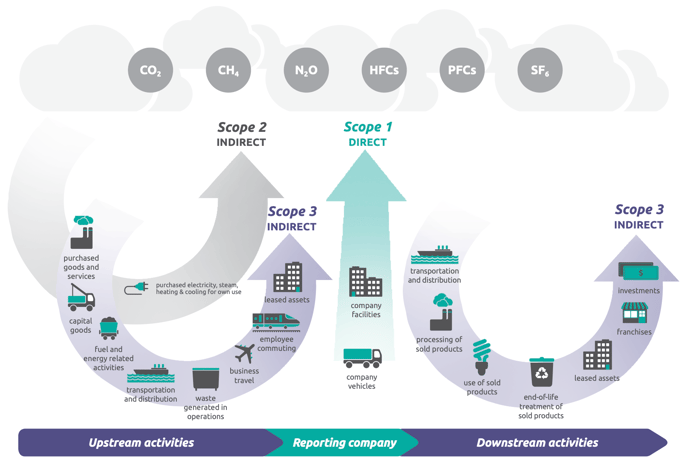GHG Emission Scopes
The GHG Protocol divides a company's emissions into three scopes.
To differentiate between various emission sources, the GHG Protocol distinguishes between three categories, which are referred to as scopes. The following diagram from the GHG Protocol Corporate Value Chain (Scope 3) standard provides an overview.

Scope 1:
Scope 1 includes all Co2 emissions that can be directly controlled by the reporting company (direct Co2 emissions). This includes the combustion of fossil fuels (mobile and stationary), Co2 emissions from chemical and physical processes and refrigerant emissions from air conditioning systems.
Scope 2:
Scope 2 emissions are indirect emissions that arise during the generation of the energy purchased by a utility company. In other words, all GHG emissions that are released into the atmosphere through the consumption of purchased electricity, steam, heating and cooling.
To differentiate: Scope 2 includes the electricity consumption of the end user, i.e. the reporting organization. The energy consumed by utilities during transmission and distribution (T&D losses), on the other hand, falls under Scope 3.
Scope 3:
All other CO2 emissions that are not under the direct control of the company are reported in Scope 3 (other indirect CO2 emissions). This includes, for example, CO2 emissions associated with products and services that are used or processed by the reporting company (upstream CO2 emissions). In addition, there are CO2 emissions associated with the use of products and services sold if direct CO2 emissions are caused in the process (downstream CO2 emissions).
In accordance with the requirements of the GHG Protocol Corporate Standard, the reporting of CO2 emissions in the Scope 1 and Scope 2 categories is mandatory. The GHG Protocol Scope 3 Standard also stipulates that companies must record relevant emissions in Scope 3. In some categories, a distinction is made between mandatory and optional emissions, which is marked accordingly in the Climate Hub.

![VERSO_Logo-1.png]](https://helpdesk.verso.de/hs-fs/hubfs/Globale%20Design-Elemente/VERSO_Logo-1.png?height=50&name=VERSO_Logo-1.png)